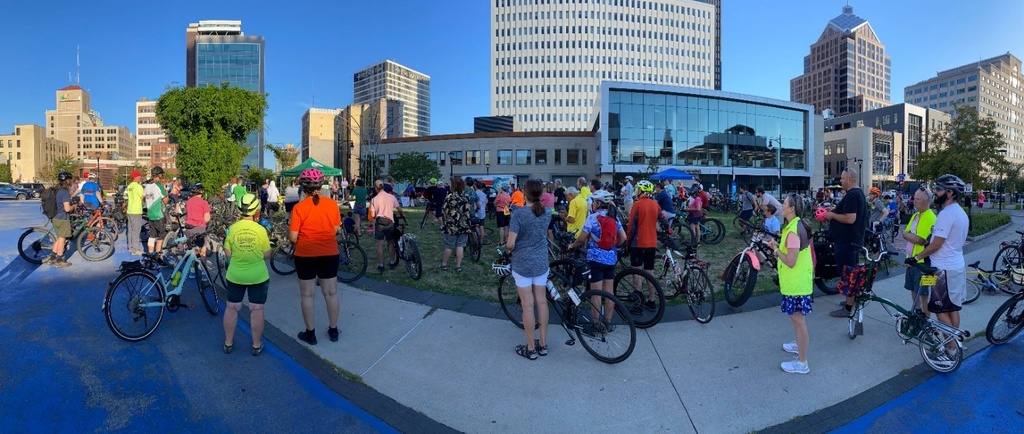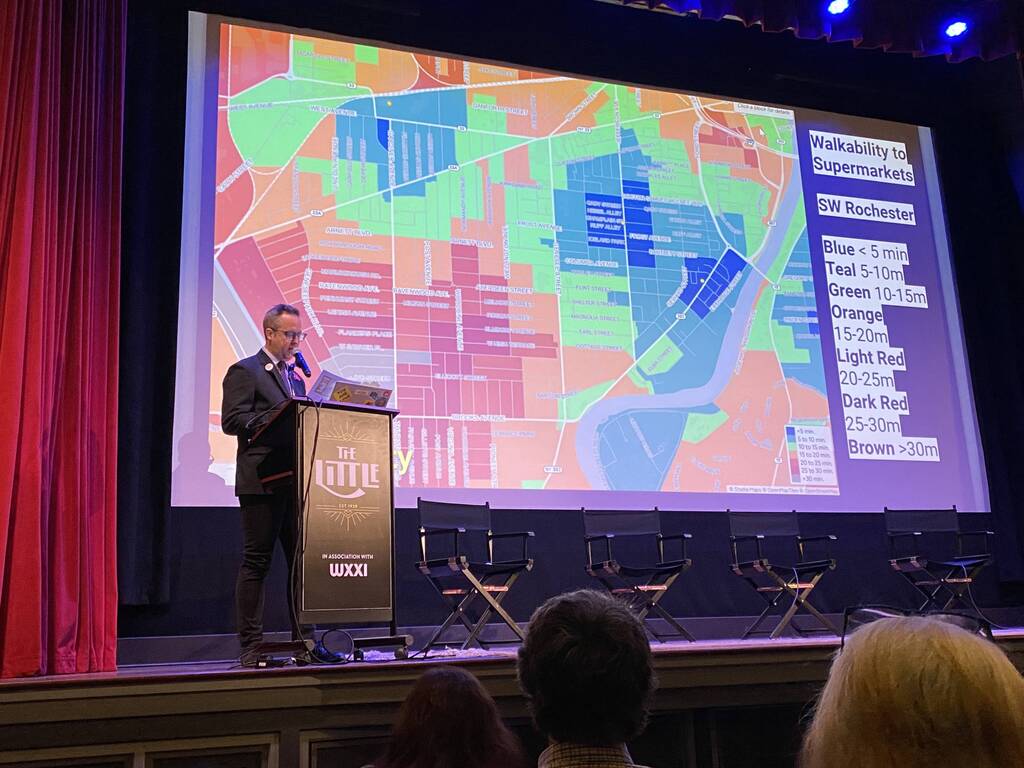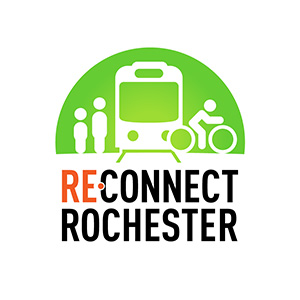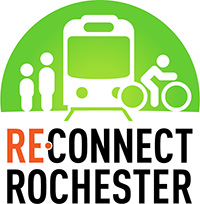Hello Reconnect Advocates! We’re entering December with a renewed energy to start planning our 2026 activities at Reconnect Rochester and reflecting on our 2025 work. We’ve heard from you that you’d like more frequent updates about the issues we asked you to advocate on. Below are some happenings from the summer and early fall around key issues that Reconnect is following:
Rochester Intermodal Station Phase II Project to add bus amenities
It’s been about 18 months since your advocacy led to Rochester being awarded $18 million in the state budget to build the bus station addition to the current train station. The project is somewhat complicated – Amtrak owns the facility, but NYSDOT built it originally and NYSDOT was given the funds. At the same time, the city is undertaking a massive Inner Loop North project across the street from the facility with a lot of changes planned to the road network. We have been in touch with Amtrak & NYSDOT to urge the kickoff of this project and to keep local stakeholders involved in the planning process so we can fully realize the vision of the intermodal station. In the meantime, we are also working with the bus companies to explore ways to improve the experience of waiting for the bus in Rochester. We successfully advocated for the city to install a simmie seat and we’re trying to get additional seating at the stop.

Keep Us Safe on State Roads Campaign

You showed up to ride to Parcel 5 to call on New York State officials to keep us safe on state roads and since then we’ve been busy continuing this advocacy. For those of you who couldn’t attend, the NYS Department of Transportation sent this statement for us to read at the event, which unfortunately didn’t give them the opportunity to see the mass of cyclists who came out to push for safer state roads. Since the event, 311 people signed a letter calling on start officials to invest in safe state road infrastructure for people walking and biking and taking transit! Behind the scenes, we’ve continued to advocate for multimodal changes to Empire Boulevard, Monroe Avenue, West Henrietta Rd. and Lake Avenue. Brighton’s Town Supervisor highlighted the strong prospect that Monroe Avenue would get a road diet, and with the right lane configuration, we could even get 5’ bike lanes on both sides. We need to keep encouraging this kind of thinking for the future.
ROC Vision Zero and 25 MPH
ROC Vision Zero work has really started to get off the ground this autumn, with public engagement planned early in the new year on the automated enforcement and speed limit changes proposed in the plan. Reconnect Rochester and the Healthi Kids Coalition have consistently advocated for speed limit reductions because that policy change alone have shown immediate safety improvements across jurisdictions. The City of Rochester joined other school districts in Monroe County by implementing Bus Patrol stop-arm cameras on school buses, but there are more opportunities to ensure that drivers are held accountable for unsafe driving. Our input is guided by the Vision Zero Network’s resource called Fair Warnings, a systematic review of safety camera programs to ensure equity in implementing the program for residents. The city deployed a seasonal protected bike lane on West Main St. this year and is still putting together a protected bike lane demonstration program alongside other safety programs that will enhance active transportation and winter maintenance.

The broader effort around 25 MPH communities applies to all the suburban towns and villages that are eligible to lower their speed limits to 25 MPH on locally-controlled roads. GTC held a regional traffic safety summit during which we exposed local leaders to the 25 MPH local law and examples in our own region that have made the switch. If you live in a suburban town or village, reach out to your decision makers to tell them you support this!
RTS Service and Budget Crisis
In June, we shared our opposition to many of the changes that RTS was implementing to their OnDemand service and we continue to dialogue with RTS on some of their choices for that service, in particular the virtual stops. We’re concerned these changes won’t improve the rider experience, and the suburbs would probably be better served by restoring some kind of fixed route service. As we move into the new year, please reach out and let us know your thoughts about bus service in the suburbs.
In the meantime, we are collaborating with RTS and the New York Public Transit Association (NYPTA) to try to spur more investment in public transit. Transit fuels economic activity and it returns many times over what it takes from the state. As a recent Streetsblog article highlighted, without renewed investments upstate, we’re going to be facing a crisis that could lead to service cuts.
Land Use and Zoning
One of the most common questions I’ve been asked lately is when will the Rochester Zoning Alignment Project be released back to the public. We’re not really sure, timelines keep getting delayed. The public probably won’t get to comment on it again formally before the City Council vote, but again that could change. We’ve been advocating for denser, mixed use zoning along transit corridors and eliminating parking minimums to spur housing in-fill development. The conversation really took off this year after the Sprawl Effect, including several workshops throughout the year on more inclusive zoning policies, blog posts from a Brighton Town Board member about eliminating parking minimums, and lots of conversations about the spiky analysis that Urban3 does. We would still love to get an Urban3 analysis for Monroe County and will keep working on finding funding for that in 2026.

Federal Headwinds – Transportation Reauthorization
Finally, federal headwinds have continued to be strong all year, but they’re about to heat up for transportation. The surface transportation bill is up for reauthorization and will have a huge impact on local projects. Genesee St, for example, was reconstructed this past year with funds from the Bipartisan Infrastructure Law, the current transportation bill. Just over the past 3 weeks, we’ve heard reports from the House Transportation and Infrastructure Committee that “walking and biking infrastructure” are not important federal priorities and there was a threat (later backtracked) to zero out public transportation funding. The Chair, Rep. Graves (R-Mo) gave an interview in which he said:
It’s going to be a traditional highway bill. That means building roads and bridges, laying asphalt, pouring concrete. We’re not going to be spending money on murals and train stations or bike paths or walking paths. We’re going to spend money on traditional infrastructure — that’s roads and bridges.
This process will keep going well into next year and there are sure to be twists and turns. To stay updated, please subscribe to Mobility Action Alerts, join the League of American Bicyclists Action list and watch for updates from Streetsblog USA.
Quick Hits
- Henry spoke on a panel at the Empire State Passengers rail symposium and they are planning to hold next year’s convening in Rochester! Stay tuned!
- We published a candidate questionnaire for city races and county races
- City of Rochester’s budget is under development – keep sharing your priorities with your elected officials
- Henry is representing us on the High Falls State Park advisory committee and a framework plan was released to the public
- Lourdes is representing us on the Alleyway Activation project, more to come!
- There are very early design discussions about reimagining Mt. Read Boulevard
- Street project meetings slowed down in the fall. Since August, we’ve submitted inputs on Seneca Ave, Broadway/S. Union, and N. Clinton. We previously submitted comments on Bull’s Head, which is getting finalized soon.

